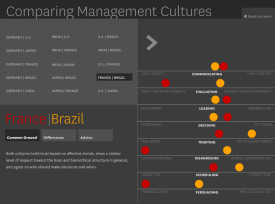To help better negotiate the complexities of cross-cultural differences and communication in the workplace, Meyer developed an interactive, online tool called the Culture Map. It is made up of eight scales representing the management behaviors where cultural gaps are most common. By comparing the position of one nationality relative to another on each scale, the user can decode how culture influences day-to-day collaboration - where the problems with each pair are most likely to occur and what you might do to mitigate them.
Other articles by Meyer to check out: Managing Confrontation In Multicultural Teams and How To Say “This Is Crap” In Different Cultures. (She is also the author of The Culture Map: Breaking Through the Invisible Boundaries of Global Business, and her Twitter account is full of good stuff too: @ErinMeyerINSEAD.)
For an academic-specific context, University Affairs article Navigating Supervision Across Cultures discusses the frequently occurring challenges in supervising graduate students across cultures, under five common themes: assumptions about the nature of research and knowledge production, cultural differences in power and status, differing needs for saving face, cultural differences in communication styles, and expectations about rule following.
FastCompany’s article 8 Ways To Reduce Your Cross-Cultural Clumsiness introduces the concept of cultural agility, which is the ability to respond quickly, comfortably, and effectively in a different culture and with people from other cultures. Written by Rutger’s Professor Paula Caligiuti, this piece offers suggestions to build a more culturally agile workforce by knowing when to adapt, integrate or override differences.



